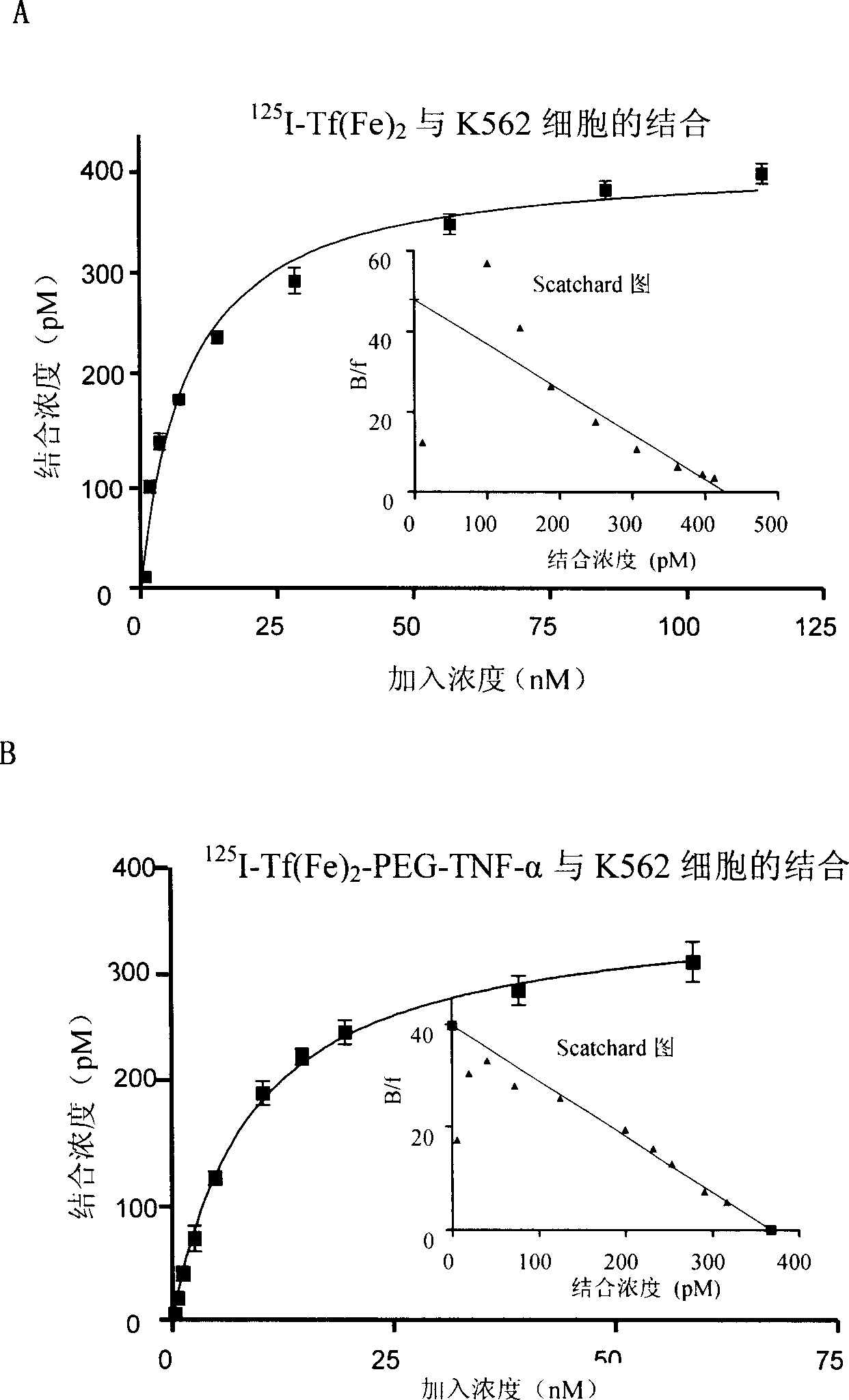Transferrin-polyethylene glycol medicine molecular compound and its use
A technology of transferrin and polyethylene glycol, which can be used in drug combinations, peptide/protein components, medical preparations of inactive ingredients, etc., can solve the problem of insignificant tumor targeting, increase drug stability, and weaken immunogens To achieve the effect of prolonging plasma half-life, enhancing anti-tumor effect and improving distribution
- Summary
- Abstract
- Description
- Claims
- Application Information
AI Technical Summary
Problems solved by technology
Method used
Image
Examples
Embodiment 1
[0058] Example 1 Preparation of Tf-PEG-tumor necrosis factor-alpha molecular complex (I)
[0059] Take 20nmol tumor necrosis factor-α (TNF-α) and 100nmol MAL-PEG-NHS (average molecular weight 3400), react in 1mL HEPES buffer (15mM, pH8.0) at 4°C for 1 hour, add 5 6-amino-n-hexanoic acid of twice the molar amount of PEG terminates the reaction. Load 0.5mL once on a cation exchange column (POROS 20HS, diameter 4.6mm, column bed volume 1.66mL), BioCAD workstation, UV detector (wavelength 280nm) for separation and purification, and collect the MAL-PEG-TNF-α fraction. Measure the contents of TNF-α and PEG in the MAL-PEG-TNF-α component respectively, and the molar ratio of TNF-α and PEG is 1: 1.9, and the yield (compared with the amount of TNF-α participating in the reaction) is 18.90% .
[0060] Dissolve 0.5 μmol of Tf in 1 mL of 30 mM HEPES buffer (containing 1 mM EDTA, pH 8.5), add 4 μmol of thiol reagent 2-iminothiophene hydrochloride, and react for 3 h at room temperature und...
Embodiment 2
[0062] Example 2 Preparation of Tf-PEG-tumor necrosis factor-alpha molecule complex (II)
[0063]Take 20nmol TNF-α and 400nmol MAL-PEG-NHS (average molecular weight 3400), in 1mL of HEPES buffer (15mM, pH8.0), react at 4°C for 1 hour, add 6- Aminocaproic acid terminates the reaction. Load 0.5mL once on a cation exchange column (POROS 20HS, diameter 4.6mm, column bed volume 1.66mL), BioCAD workstation, UV detector (wavelength 280nm) for separation and purification, and collect the MAL-PEG-TNF-α fraction. Measure the contents of TNF-α and PEG in the MAL-PEG-TNF-α component respectively, the molar ratio of TNF-α and PEG is 1: 2.6, and the yield (compared with the amount of TNF-α participating in the reaction) is 50.44% .
[0064] Dissolve 0.5 μmol of Tf in 1 mL of 30 mM HEPES buffer (containing 1 mM EDTA, pH 8.5), add 4 μmol of thiol reagent 2-iminothiophene hydrochloride, and react for 3 h at room temperature under argon. The reaction product is passed through a gel desalting...
Embodiment 3
[0065] Example 3 Preparation of Tf-PEG-tumor necrosis factor-alpha molecule complex (III)
[0066] Take 20nmol TNF-α and 800nmol MAL-PEG-NHS (average molecular weight 3400), in 1mL of HEPES buffer (15mM, pH8.0), react at 4°C for 1 hour, add 6- Aminocaproic acid terminates the reaction. Load 0.5mL once on a cation exchange column (POROS 20HS, diameter 4.6mm, column bed volume 1.66mL), BioCAD workstation, UV detector (wavelength 280nm) for separation and purification, and collect the MAL-PEG-TNF-α fraction. Measure the contents of TNF-α and PEG in the MAL-PEG-TNF-α component respectively, and the molar ratio of TNF-α and PEG is 1: 3.7, and the yield (compared with the amount of TNF-α participating in the reaction) is 60.81%. .
[0067] Dissolve 0.5 μmol of Tf in 1 mL of 30 mM HEPES buffer (containing 1 mM EDTA, pH 8.5), add 4 μmol of thiol reagent 2-iminothiophene hydrochloride, and react for 3 h at room temperature under argon. The reaction product is passed through the gel ...
PUM
| Property | Measurement | Unit |
|---|---|---|
| molecular weight | aaaaa | aaaaa |
Abstract
Description
Claims
Application Information
 Login to View More
Login to View More - R&D
- Intellectual Property
- Life Sciences
- Materials
- Tech Scout
- Unparalleled Data Quality
- Higher Quality Content
- 60% Fewer Hallucinations
Browse by: Latest US Patents, China's latest patents, Technical Efficacy Thesaurus, Application Domain, Technology Topic, Popular Technical Reports.
© 2025 PatSnap. All rights reserved.Legal|Privacy policy|Modern Slavery Act Transparency Statement|Sitemap|About US| Contact US: help@patsnap.com



